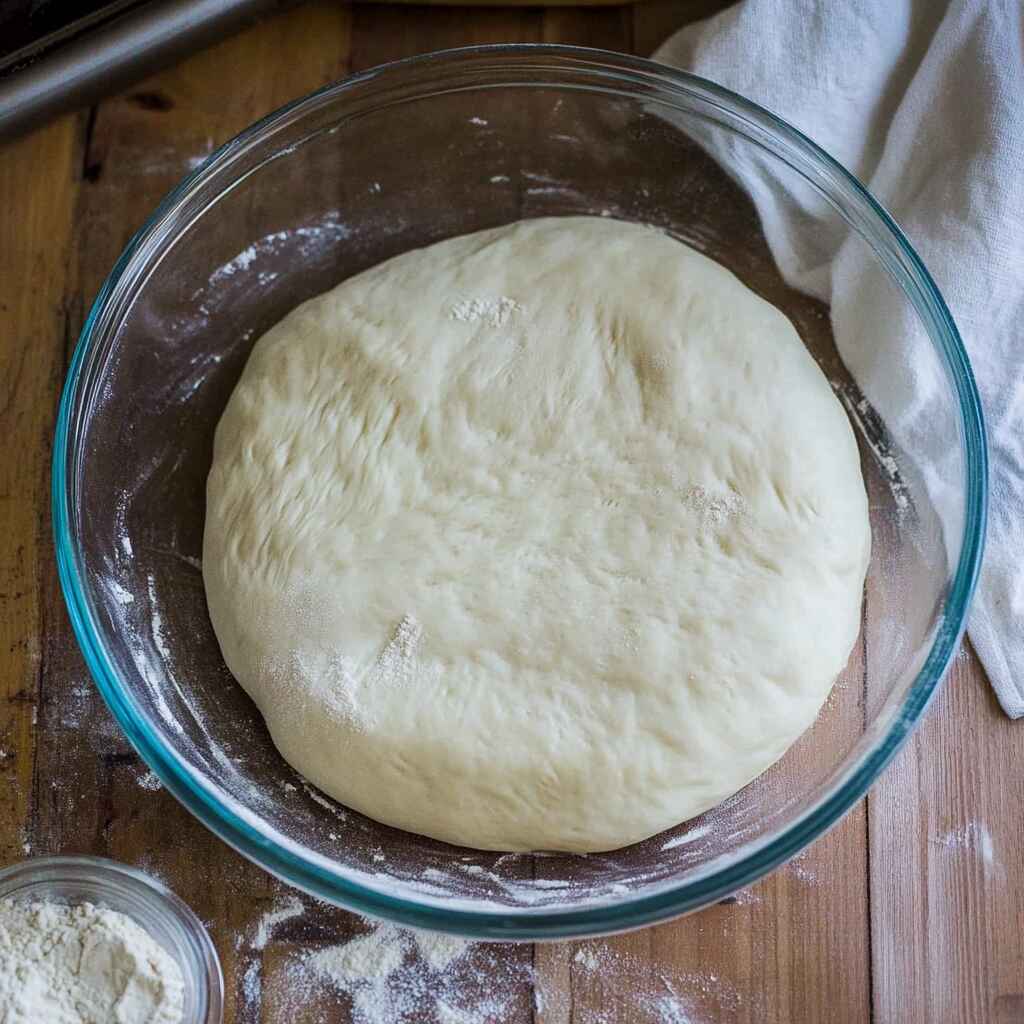It started with bread. My grandfather, a quiet man with weathered hands, used to make the softest loaves I’d ever tasted. His dough would rest under a damp towel near the wood-burning stove while he sipped tea and told stories about growing up in Sicily. That same soft, forgiving dough eventually evolved into our family’s favorite pizza dough recipe. Not because we planned it, but because good recipes have a way of finding new life.
As a teenager, I began playing with that dough less hydration here, a longer rise thereuntil one night, my brother said, “This tastes better than takeout.” That was the beginning of our Friday night pizza ritual. Over time, I fine-tuned the process: just the right amount of yeast, a long cold ferment when I had the time, and a high-heat oven that made the crust bubble and char in the best way. Today, it’s the dough I reach for when I want to feel connected to family, to tradition, and to the joy of a meal that brings everyone to the table.
Mastering the Dough: Step-by-Step Pizza Dough Recipe
Flour, water, yeast your new go-to dough starts here
A great pizza dough recipe doesn’t need to be complicated. It just needs balance: between softness and strength, stretch and chew. This dough is beginner-friendly but delivers professional results with minimal fuss. The process is simple no mixers or fancy tools required.
Start with the basics. In a large bowl, combine 2¼ teaspoons of active dry yeast with 1½ cups of warm water (around 110°F). Let it sit for 5 to 10 minutes until foamy. That’s your signal the yeast is alive and ready. Now, add 3½ cups of all-purpose flour, 1 tablespoon of olive oil, and 2 teaspoons of salt. Mix until a shaggy dough forms.
Turn it out onto a floured surface and knead for about 8–10 minutes. You’re building gluten here the web of proteins that gives the dough its stretch. It should feel smooth and springy. If it’s sticky, dust in a little more flour as you go.
Once kneaded, place the dough in a lightly oiled bowl, cover it with a towel, and let it rise in a warm spot until doubled in size about 1 to 1½ hours. For even better flavor, let it rise slowly in the fridge overnight. Cold fermentation deepens the taste and makes the dough easier to shape.
This dough makes two 12-inch pizzas. Divide it in half and form each into a tight ball. Let them rest 15–20 minutes before stretching this makes shaping much easier and avoids tearing.
Bake It Right: Pizza Dough Recipe in Action
Your guide to heat, pans, and crust perfection
Now that your pizza dough is soft, rested, and ready it’s time to bake like a pro. The best pizza dough recipe delivers when it hits the heat, and that’s where technique makes all the difference. Whether you’re using a pizza stone, cast iron, or a regular sheet pan, it’s all about high heat and fast bake time.
Start by preheating your oven to 475–500°F for at least 30 minutes. If you have a pizza stone, place it in the oven before preheating to ensure it gets blazing hot. No stone? A heavy-duty sheet pan works great too just lightly oil it or sprinkle with cornmeal to prevent sticking.
Gently stretch your dough into a 12-inch round. Avoid using a rolling pin it pushes out the air bubbles. If the dough resists stretching, let it rest for a few minutes and try again. Place it on your prepared surface, add your sauce and toppings, and slide it into the oven.
Bake for 10–12 minutes or until the crust is golden and the cheese is bubbling. Rotate once during baking for even browning. If you’re using a sheet pan, you may need 1–2 extra minutes for full crispness underneath.
For crispier results, par-bake the crust for 5 minutes before adding toppings. And for an extra boost in flavor? Brush the edges with garlic oil or sprinkle a little sea salt on the crust before it goes in.
Customize It: Pizza Dough Recipe Variations & Storage
Flexible, forgiving, and ready when you are
One of the best things about this pizza dough recipe is how easily it adapts to your needs. Whether you’re planning for a busy weeknight or catering to dietary preferences, this dough gives you options without sacrificing flavor or texture.
Need gluten-free? Swap in a 1:1 gluten-free flour blend. Be aware that gluten-free doughs need less kneading and tend to rise differently—so follow the same process but let the dough rest slightly longer. You’ll get a chewy, satisfying crust with just a little practice.
Want whole wheat? Replace half of the all-purpose flour with whole wheat flour. This boosts the nutty flavor and makes a slightly denser crust. You may need a touch more water to keep the dough supple, but the results are hearty and delicious.
In a rush? Use warm water (about 110°F) and a full tablespoon of yeast. Your dough will rise in just 30–40 minutes. It won’t have the same deep flavor as a slow-fermented dough, but it’s still miles ahead of anything store-bought.
Now, for storing: After the first rise, you can refrigerate the dough for up to 72 hours. Just wrap it tightly in plastic or keep it in an airtight container. Want to freeze it? Lightly coat the dough in olive oil, seal it in a freezer bag, and store for up to 3 months. Thaw overnight in the fridge, then let it come to room temp before shaping.
Frequently Asked Questions
1. What is the secret to a perfect pizza dough recipe?
The secret is using quality ingredients, giving the dough enough time to rise, and baking it at a very high temperature. Letting the dough rest overnight in the fridge improves flavor and texture. A long, slow rise builds better gluten structure, which means a chewier, airier crust.
2. Can I freeze pizza dough?
Yes! After the dough rises, lightly coat it with oil, seal it in a freezer bag, and freeze for up to 3 months. When ready to use, thaw in the refrigerator overnight and bring to room temperature before shaping and baking.
3. How long should I let pizza dough rise?
Let your pizza dough rise for 1 to 1½ hours at room temperature until doubled in size. For deeper flavor, refrigerate it for 24–72 hours. This slow fermentation breaks down starches and enhances the crust’s taste and texture.
4. Can I make pizza dough without yeast?
Yes, but the texture will be more biscuit-like than chewy. Substitute the yeast with 1 tablespoon of baking powder and skip the rising time. This no-yeast pizza dough recipe works best for thin, quick-bake crusts.
Conclusion: Your New Favorite Pizza Dough Recipe
There’s something timeless about creating a pizza from scratch the feel of the dough, the warmth of the oven, the satisfaction of the first slice. With this pizza dough recipe, you’ve got a reliable, flexible foundation for pizza nights, family dinners, or even freezer-friendly meal prep. And best of all? It’s simple, made with love, and always better than store-bought. Keep this recipe close it’s going to become a part of your story too.

Pizza Dough Recipe
Ingredients
Method
- In a large bowl, mix warm water and yeast. Let sit 5–10 minutes until foamy.
- Add flour, olive oil, and salt. Mix until shaggy dough forms.
- Knead on floured surface for 8–10 minutes until smooth and elastic.
- Place in oiled bowl, cover, and let rise for 1–1½ hours or until doubled.
- Punch down dough, divide into 2 balls. Let rest 15–20 minutes before shaping.
- Stretch into 12-inch rounds, top, and bake at 500°F for 10–12 minutes.
